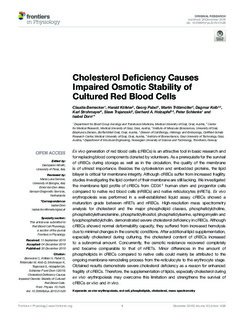| dc.contributor.author | Bernecker, Claudia | |
| dc.contributor.author | Köfeler, Harald | |
| dc.contributor.author | Pabst, Georg | |
| dc.contributor.author | Trötzmüller, Martin | |
| dc.contributor.author | Kolb, Dagmar | |
| dc.contributor.author | Strohmayer, Karl | |
| dc.contributor.author | Trajanoski, Slave | |
| dc.contributor.author | Holzapfel, Gerhard | |
| dc.contributor.author | Schlenke, Peter | |
| dc.contributor.author | Dorn, Isabel | |
| dc.date.accessioned | 2020-02-18T13:54:11Z | |
| dc.date.available | 2020-02-18T13:54:11Z | |
| dc.date.created | 2020-01-28T12:18:09Z | |
| dc.date.issued | 2019 | |
| dc.identifier.issn | 1664-042X | |
| dc.identifier.uri | http://hdl.handle.net/11250/2642352 | |
| dc.description.abstract | Ex vivo generation of red blood cells (cRBCs) is an attractive tool in basic research and for replacing blood components donated by volunteers. As a prerequisite for the survival of cRBCs during storage as well as in the circulation, the quality of the membrane is of utmost importance. Besides the cytoskeleton and embedded proteins, the lipid bilayer is critical for membrane integrity. Although cRBCs suffer from increased fragility, studies investigating the lipid content of their membrane are still lacking. We investigated the membrane lipid profile of cRBCs from CD34+ human stem and progenitor cells compared to native red blood cells (nRBCs) and native reticulocytes (nRETs). Ex vivo erythropoiesis was performed in a well-established liquid assay. cRBCs showed a maturation grade between nRETs and nRBCs. High-resolution mass spectrometry analysis for cholesterol and the major phospholipid classes, phosphatidylcholine, phosphatidylethanolamine, phosphatidylinositol, phosphatidylserine, sphingomyelin and lysophosphatidylcholin, demonstrated severe cholesterol deficiency in cRBCs. Although cRBCs showed normal deformability capacity, they suffered from increased hemolysis due to minimal changes in the osmotic conditions. After additional lipid supplementation, especially cholesterol during culturing, the cholesterol content of cRBCs increased to a subnormal amount. Concurrently, the osmotic resistance recovered completely and became comparable to that of nRETs. Minor differences in the amount of phospholipids in cRBCs compared to native cells could mainly be attributed to the ongoing membrane remodeling process from the reticulocyte to the erythrocyte stage. Obtained results demonstrate severe cholesterol deficiency as a reason for enhanced fragility of cRBCs. Therefore, the supplementation of lipids, especially cholesterol during ex vivo erythropoiesis may overcome this limitation and strengthens the survival of cRBCs ex vivo and in vivo. | nb_NO |
| dc.language.iso | eng | nb_NO |
| dc.publisher | Frontiers Media | nb_NO |
| dc.rights | Navngivelse 4.0 Internasjonal | * |
| dc.rights.uri | http://creativecommons.org/licenses/by/4.0/deed.no | * |
| dc.title | Cholesterol Deficiency Causes Impaired Osmotic Stability of Cultured Red Blood Cells | nb_NO |
| dc.type | Journal article | nb_NO |
| dc.type | Peer reviewed | nb_NO |
| dc.description.version | publishedVersion | nb_NO |
| dc.source.volume | 10 | nb_NO |
| dc.source.journal | Frontiers in Physiology | nb_NO |
| dc.identifier.doi | 10.3389/fphys.2019.01529 | |
| dc.identifier.cristin | 1783991 | |
| dc.description.localcode | Copyright © 2019 Bernecker, Köfeler, Pabst, Trötzmüller, Kolb, Strohmayer, Trajanoski, Holzapfel, Schlenke and Dorn. This is an open-access article distributed under the terms of the Creative Commons Attribution License (CC BY). The use, distribution or reproduction in other forums is permitted, provided the original author(s) and the copyright owner(s) are credited and that the original publication in this journal is cited, in accordance with accepted academic practice. No use, distribution or reproduction is permitted which does not comply with these terms. | nb_NO |
| cristin.unitcode | 194,64,45,0 | |
| cristin.unitname | Institutt for konstruksjonsteknikk | |
| cristin.ispublished | true | |
| cristin.fulltext | original | |
| cristin.qualitycode | 1 | |

